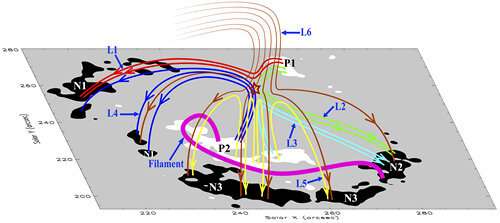The result suggested that the reconnection is significantly accelerated by the propagating disturbance caused by the adjacent filament eruption.
The study was published in the Astrophysical Journal on Feb. 20.
The New Vacuum Solar Telescope (NVST) is a one meter ground-based solar telescope, located in the Fuxian Solar Observatory of Yunnan Astronomical Observatories of Chinese Academy of Sciences (YNAO). It provides observations of the solar fine structures and their evolution in the solar lower atmosphere.
The NVST observed the active region 11696 on March 15, 2013, in the Hα channel, centered at 6562.8 angstrom with a bandwidth of 0.25 angstrom.
Employing the NVST Hα images with higher spatial resolution, the researchers studied the evolution of magnetic loops and their nearby filament in the active region, combining the Atmospheric Imaging Assembly (AIA) extreme ultraviolet (EUV) images and Helioseismic and Magnetic Imager (HMI) line-of-sight magnetograms on board the Solar Dynamic Observatory (SDO).
In NVST Hα images, two groups of fibrils converged and interacted with each other. Two sets of newly formed fibrils then appeared and retracted away from the interaction region.
"The result provides clear evidence of magnetic reconnection," said Prof. Hardi Peter from Max-Planck Institute for Solar System Research (MPS), a co-author of this study. In AIA EUV images, the current sheet formed repeatedly in the reconnection region in the lower-temperature channels, and plasmoids appeared in the current sheet and propagated along it bi-directionally.
A filament was located to the southeast of the reconnection region. It erupted, and pushed away the loops covering the reconnection region. "The filament eruption leads to a disturbance propagating outward across the reconnection region," said Dr. Li Leping, the first author of this study.
Thereafter, the current sheet became shorter and brighter, with a larger reconnection rate. It appeared in the AIA higher-temperature channels. In the current sheet, more and hotter plasmoids formed.
"Comparing with the observations before the filament eruption during the same time intervals, more thermal and kinetic energy is converted through reconnection after the filament eruption," said Dr. LI. "The reconnection is thus significantly accelerated by the propagating disturbance caused by the nearby filament eruption."
Explore further



